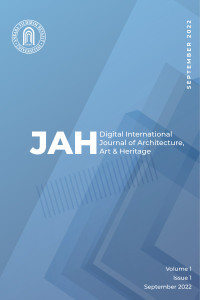Sistem İlişkileri Açısından Sürdürülebilir Sağlıklı Yapı Üretimi Kuramsal Modeli
Sürdürülebilirlik, Sürdürülebilir sağlıklı yapı, Sistem ilişkileri, Yapı üretim sistemi, Yapı sistemi
Sustainable Healthy Building Production Theoretical Model in Terms of System Relations
Sustainability, Sustainable healthy building, System relations, Building production system, Building system,
___
- Akkuş, B., İzci, A. N. (2018). Sistem Yaklaşımı, Kavramları ve Yönetim. Recep Tayyip Erdogan University Journal of Social Sciences, 4(7), 223-237.
- Arsan, Z. D. (2008). Türkiye’de Sürdürülebilir Mimari. Mimarlık Dergisi Ankara, 340, 21-30.
- Aykanat, A. (2021). Ders notları.
- Aykanat, A. (2023). Sürdürülebilir Gelecek için Alternatif Enerji Kaynakları. Nobel Yayınevi, Ostim Teknik Üniversitesi Yayını, Ankara.
- Baysan, O. (2003). Sürdürülebilirlik Kavramı ve Mimarlıkta Tasarıma Yansıması. [Yüksek Lisans Tezi, İstanbul Teknik Üniversitesi, Fen Bilimleri Enstitüsü].
- Berköz, S. (1975). Yapım’da Sistemler Yaklaşımı. İTÜ Mimarlık Fakültesi Baskı Atölyesi, İstanbul.
- Bozloğan, R. (2005). Sürdürülebilir Gelişme Düşüncesinin Tarihsel Arka Planı. Sosyal Siyaset Konferansları Dergisi, İstanbul Üniversitesi, İktisat Fakültesi Yayını, 50, 1011-1028.
- Campbell, S. (1996). Green Cities, Growing Cities, Just Cities? Urban Planning and the Contradictions of Sustainable Development. Journal of the American Planning Association, 62(3), 296-311. Ciravoğlu, A. (2006). Sürdürülebilirlik Düşüncesi-Mimarlık Etkileşimine Alternatif Bir Bakış: Yer’in Çevre Bilincine Etkisi. [Doktora Tezi, Yıldız Teknik Üniversitesi, F.B.E. Mimarlık Anabilim Dalında Bina Araştırma ve Planlama Programı].
- Coşkun, C., Oktay, Z., Ertürk, M. (2010). Konutların Isıtma Sezonunda Seçilen İç Ortam Sıcaklık Parametresinin Enerji-Maliyet-Çevre Açısından Değerlendirilmesi ve Bir Uygulama Örneği. Tesisat Mühendisliği Dergisi 10(43), 28-35.
- Çağnan, Ç., Özer, H. (2014). Yapı Üretiminde Sistem Yaklaşımı ile Yapı Ürünü Performanslarının Çevre-Ekoloji ve Yasal Zorunluluklar Bağlamında Test Edilmesine Yönelik Bir Model Önerisi. Megaron, 9(4), 255-270. DOI: 10.5505/MEGARON.2014.29491.
- Dinçer, Ö. (2009). Sistem Yaklaşımı. Retrieved May 14, 2016, from http://www.enfal.de/sosyalbilimler/s/032.htm
- Erengezgin, Ç. (2005). Enerji Mimarlığı. Ege Üniversitesi Güneş Enerjisi Enstitüsü, 4. Yenilenebilir Enerjiler Sempozyumu ve Sanayi Sergisi Bildiri Özetleri, (pp. 47-48).
- Frey, W. (2010). Das Fünf-Finger-Prinzip: Strategien für eine nachhaltige Architektur. Herder. ISBN 978-3-451-30387-6.
- Hamans, C. (2014). Binalarda Sürdürülebilirlik. Retrieved April 24, 2020, from https://www.ekoyapidergisi.org/binalarda-surdurulebilirlik
- Kafesçioğlu, R. (2017). Çağdaş Yapı Malzemesi Toprak ve Alker. İstanbul, İTÜ Vakfı Yayınları.
- Koçel, T. (1984). Yönetimde Sistem Yaklaşımı, İş İdaresi. Anadolu Üniversitesi Açık Öğretim Fakültesi Yayınları, Ankara.
- Küçük, O., Demirdöğen, O. (2013). Üretim İşlemler Yönetimi (3. Baskı). Detay Yayıncılık, Ankara.
- Mele, C., Pels, ., Polese, F. (2010). A Brief Review of Systems Theories and Their Managerial Applications. Service Science, 2(1-2), 126 – 135. Nachhaltiges Bauen. Strategien – Methodik – Praxis. BBSR-Berichte KOMPAKT 14/2010. Hrsg. v. Bundesinstitut für Bau-, Stadt- und Raumforschung im Bundesamt für Bauwesen und Raumforschung. S. 11.
- Özmehmet, E. (2007). Avrupa ve Türkiye’deki Sürdürülebilir Mimarlık Anlayışına Eleştirel Bir Bakış. Journal of Yasar University, 2(7), 809-826.
- Perker, Z. S. (2012). Sistem Yaklaşımı Bağlamında Bir Girdi ve Sistem Olarak Geleneksel Anadolu Konutu. e-Journal of New World Sciences Academy, 7(2), 554-571.
- Utkutuğ, G. (2012). Çevre ve Yaşam İçin Tasarım: Ekolojik Tasarım. Çevreye Duyarlı Tasarım Konferansları II, Atılım Üniversitesi, Ankara.
- URL-1.Monien, F. Ganzheitliche Managementansätze stärken Wohnungsunternehmen nachhaltig. Retrieved October 10, 2022, from http://www.controllingportal.de/Fachinfo/Branchen/Ganzheitliche-Managementansaetze-staerken-Wohnungsunternehmen-nachhaltig.html
- URL-2. Jochum, G. Der Deutsche Diskurs zu nachhaltiger Entwicklung. Retrieved October 10, 2022, from http://www.researchgate.net/profile/Georg_Jochum/publication/272826221_Der_Deutsche_Diskurs_zu_nachhaltiger_Entwicklung/links/54f07d7c0cf24eb87940aaf8/Der-Deutsche-Diskurs-zu-nachhaltiger-entwicklung
- URL-3.Retrieved October 10, 2022, from http://www.freyarchitekten.com/ nachhaltigkeit/oekonomie.html
- URL-4. Bewertungssystem Nachhaltiges Bauen Büro- und Verwaltung. Retrieved March 20, 2023, from https://www.nachhaltigesbauen.de/fileadmin/pdf/veroeffentlichungen/Bewertungssystem_Nachhaltiges_Bauen.pdf
- Turner, G. (2008). A Comparison of the Limits to Growth With 30 Years of Reality. Global Environmental Change, 18(3), 397-411.
- Yılmaz, D., Keskin, K. (2019). Farklı Bakış Açılarıyla Sürdürülebilir Mimarlık-Estetik İlişkisinin Kurulması. Mimarlık ve Yaşam Dergisi Journal of Architecture and Life, 5(1), 145-160. DOI: 10.26835/my.667820.
- Başlangıç: 2022
- Yayıncı: Ankara Yıldırım Beyazıt Üniversitesi
Edirne/Keşan Çamlıca (Grabuna) Köyü’nde Kırsal Mimari ve Koruma Sorunları
Tahsin Aykut ÇETİNMAKAS, Tülay CANITEZ
Reading the Architectural Design Processes of University Campus Entrance Gates
Architectural Features of the Agora(Bazaar) of the Ancient City of Anastiopolis (Dara)
Lale KARATAŞ, Murat DAL, Devrim Hasan MENTEŞE
Calvino’nun Görünmez Kentlerine Farklı Bir Bakış: Görünür Hale Getirerek Dijitale Taşımak
Demolished Public Buildings: The Discontinuity of National Competition Memory
Adıyaman University Campus Plan: Design, Development and Snapshot after Earthquake
Discourses/Actions: The Nation's Library
Çiğdem YILDIRIM, Fatih Çağrı AKÇAY
Çankırı, Kurşunlu, Çarşı Han Yapısı Belgeleme ve Restitüsyon Analizi
Ammar İBRAHİMGİL, Halime Sertaç AKYOL
Sistem İlişkileri Açısından Sürdürülebilir Sağlıklı Yapı Üretimi Kuramsal Modeli
